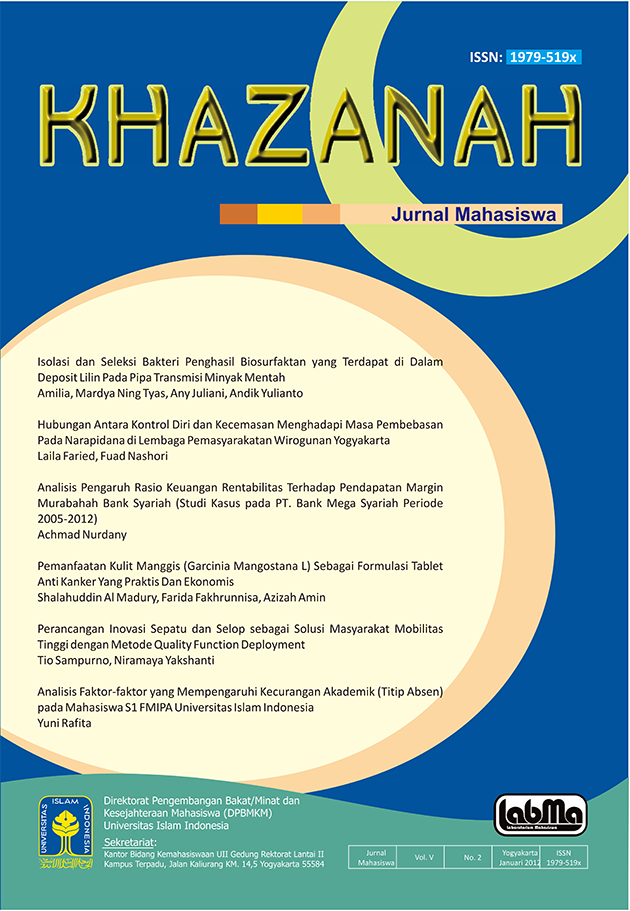Main Article Content
Abstract
The purpose of this research was to understand the corelation between selfcontrols and the anxiety of the prisoner to face the liberation. The hypothesis of this research showed that there was negative corelation between self-control and the anxiety of the prisoner to face the liberation. The higher self-control the lower anxiety to face the liberation, so on the contrary, the lower self-control the higher the anxiety to face the liberation. The subjects of this research were men and women prisoners from correctional facility, who would be immediately liberated 5 to 6 months approaching the liberation. The scale which was used in this research was self-control scale, which was arranged by the researcher based on Averiil theory (1973) and anxiety based on Rosenhan and Seligman Theory (1989). The research’s method to analyze the data was SPSS 17.0. This method was used to verify the negative corelation between self-control and anxiety of prisoners to face the liberation. Product moment correlation of Pearson showed the value of r = - 0,451 and p = 0.007 (p>0, 01), which meant there was a significant negative correlation between self-control and anxiety of prisoners to face liberation.
Article Details
1. Proposed Policy for Journals That Offer Open Access
Authors who publish with this journal agree to the following terms:- Authors retain copyright and grant the journal right of first publication with the work simultaneously licensed under a Creative Commons Attribution License that allows others to share the work with an acknowledgement of the work's authorship and initial publication in this journal.
- Authors are able to enter into separate, additional contractual arrangements for the non-exclusive distribution of the journal's published version of the work (e.g., post it to an institutional repository or publish it in a book), with an acknowledgement of its initial publication in this journal.
- Authors are permitted and encouraged to post their work online (e.g., in institutional repositories or on their website) prior to and during the submission process, as it can lead to productive exchanges, as well as earlier and greater citation of published work (See The Effect of Open Access).
2. Proposed Policy for Journals That Offer Delayed Open Access
Authors who publish with this journal agree to the following terms:- Authors retain copyright and grant the journal right of first publication, with the work [SPECIFY PERIOD OF TIME] after publication simultaneously licensed under a Creative Commons Attribution License that allows others to share the work with an acknowledgement of the work's authorship and initial publication in this journal.
- Authors are able to enter into separate, additional contractual arrangements for the non-exclusive distribution of the journal's published version of the work (e.g., post it to an institutional repository or publish it in a book), with an acknowledgement of its initial publication in this journal.
- Authors are permitted and encouraged to post their work online (e.g., in institutional repositories or on their website) prior to and during the submission process, as it can lead to productive exchanges, as well as earlier and greater citation of published work (See The Effect of Open Access).
References
- Averill. J.R.. 1973. Personal Control Over Aversive Stimuli and Its Relationship to Stress. Psychological Bulletin, 80 (4), 286-303.
- Chaplin, J. P. 2001. Kamus Lengkap Psikologi. Jakarta: Rajawali Press.
- Daradjat, Z. 1990. Kesehatan Mental. Jakarta: Gunung Agung.
- Harsono, C.I. 1995. Sistem Baru Pembinaan Narapidana. Jakarta: Djambatan.
- Hurlock, EB. 1997. Psikologi Perkembangan: Suatu Pendekatan Sepanjang Rentang Kehidupan. Alih Bahasa Istiwidayanti. Jakarta: Penerbit Erlangga.
- Jannah, M & Rahayu, S, 2007. Perilaku Penunda Kepuasan Ditinjau dari Kontrol Diri dan Inteligensi Pada Anak Usia Sekolah. Jurnal Pendidikan Dasar, 18 (1), 8-14.
- Kartono, K. 1981. Gangguan-gangguan Psikis. Bandung. Sinar Baru.
- Kartono, K. 1995. Patologi Sosial Jilid 1. Jakarta: PT. Raja Grafindo Persada.
- Lazarus, R.S. 1976. Pattern of Adjustment. Tokyo: Mc Graw-Hill Kogakhusu Inc.
- Nevid, J. S., Rathus, S. A., & Greene, B. 2005. Psikologi Abnormal Edisi Kelima Jilid 1. Jakarta: Erlangga.
- Rosenhan, D. L & Seligman, E.P. 1989. Abnormal Psychology, 2th Edition. New York: W.W. Norton & Company Inc.
- Triastuti, D., Sutikno, N., & Risnawaty, W. 2009. Gambaran Kecemasan dan Strategi Penanganan Anak Didik Kasus Pembunuhan: Studi Kasus Andik yang Telah Memasuki Masa Asimilasi di Lapas Anak Pria Tangerang. Jurnal Arkhe Universitas Tarumanegara, 1, 31-39.
- Ulyani, F . 2003 Hubungan Antara Menghadapi Masa Pembebasan dan Lamanya Masa Pidana dengan Kepercayaan Diri Narapidana. Skripsi (Tidak Diterbitkan). Yogyakarta: Fakultas Psikologi Universitas Islam Indonesia
References
Averill. J.R.. 1973. Personal Control Over Aversive Stimuli and Its Relationship to Stress. Psychological Bulletin, 80 (4), 286-303.
Chaplin, J. P. 2001. Kamus Lengkap Psikologi. Jakarta: Rajawali Press.
Daradjat, Z. 1990. Kesehatan Mental. Jakarta: Gunung Agung.
Harsono, C.I. 1995. Sistem Baru Pembinaan Narapidana. Jakarta: Djambatan.
Hurlock, EB. 1997. Psikologi Perkembangan: Suatu Pendekatan Sepanjang Rentang Kehidupan. Alih Bahasa Istiwidayanti. Jakarta: Penerbit Erlangga.
Jannah, M & Rahayu, S, 2007. Perilaku Penunda Kepuasan Ditinjau dari Kontrol Diri dan Inteligensi Pada Anak Usia Sekolah. Jurnal Pendidikan Dasar, 18 (1), 8-14.
Kartono, K. 1981. Gangguan-gangguan Psikis. Bandung. Sinar Baru.
Kartono, K. 1995. Patologi Sosial Jilid 1. Jakarta: PT. Raja Grafindo Persada.
Lazarus, R.S. 1976. Pattern of Adjustment. Tokyo: Mc Graw-Hill Kogakhusu Inc.
Nevid, J. S., Rathus, S. A., & Greene, B. 2005. Psikologi Abnormal Edisi Kelima Jilid 1. Jakarta: Erlangga.
Rosenhan, D. L & Seligman, E.P. 1989. Abnormal Psychology, 2th Edition. New York: W.W. Norton & Company Inc.
Triastuti, D., Sutikno, N., & Risnawaty, W. 2009. Gambaran Kecemasan dan Strategi Penanganan Anak Didik Kasus Pembunuhan: Studi Kasus Andik yang Telah Memasuki Masa Asimilasi di Lapas Anak Pria Tangerang. Jurnal Arkhe Universitas Tarumanegara, 1, 31-39.
Ulyani, F . 2003 Hubungan Antara Menghadapi Masa Pembebasan dan Lamanya Masa Pidana dengan Kepercayaan Diri Narapidana. Skripsi (Tidak Diterbitkan). Yogyakarta: Fakultas Psikologi Universitas Islam Indonesia
